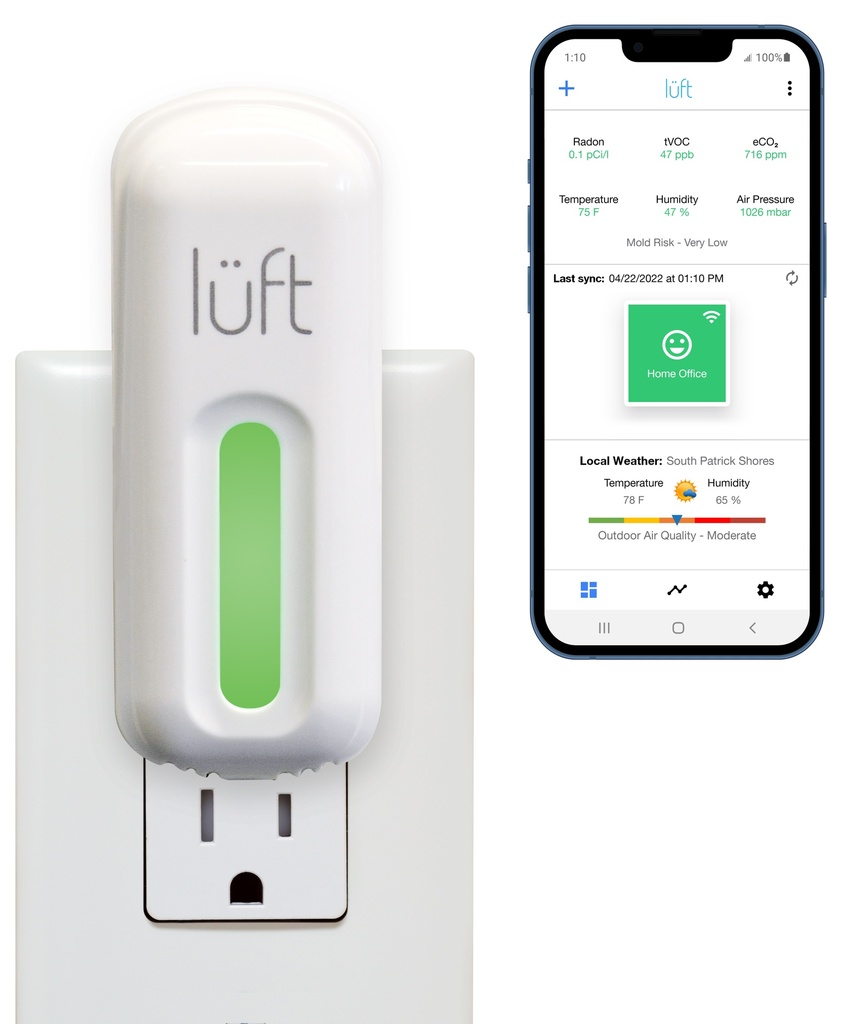Indoor Air Quality
Monitor the Air Quality of Your Home!
When it comes to making sure their homes are healthy and safe, many people tend to focus on cleaning and getting rid of clutter. However, what many people fail to consider is the quality of the air they breathe inside their homes. Indoor air quality (IAQ) refers to the quality of the air within and around buildings and structures, especially as it relates to the health and comfort of those who occupy them. Poor indoor air quality can lead to a range of negative health effects, including headaches, dizziness, fatigue, respiratory issues, and allergies.
One particularly concerning and naturally occurring radioactive gas that can be found in homes is radon. Radon is normal to find at low levels in homes, but it becomes worrisome as you cannot see it or smell it, and breathing in radon over long periods of time can result in long-term health issues, including lung cancer. In fact, long term exposure to high levels of radon is the leading cause of this terrible disease among non-smokers.

As mentioned, at low levels, radon is not a concern, but the levels present in your home can fluctuate depending on the season, your air flow, the ventilation in certain areas, etc. For your own peace of mind, and as a solution to the problem of poor air quality in your home, we are happy to offer the following product – our Lüft Indoor Air Quality Monitor.
This monitor easily plugs into any of your outlets and connects directly to your phone via WiFi and Bluetooth. When plugged in, this monitor checks continuously for levels of radon, carbon monoxide, and other harmful chemicals or gases, and delivers this information directly to your phone through an app. This system alerts you when any levels are of concern and allows you to take care of any problems before they arise.
We are proud to offer this state-of-the art, affordable, and American-made product to our customers, as we care about you and your family’s safety, as well!
To learn more about your own Indoor Air Quality and how to monitor your home gas’ such as radon, carbon monoxide, and more, reach out to Dineen Home Inspections today!
Protect What Matters Most
Our monitor is uniquely designed to continuously measure the quality of the air you breathe by measuring radon as well as dangerous chemicals (tVOCs), carbon dioxide equivalents (eCO2), temperature, humidity, and pressure—all to ensure the air you and your family breathe is healthy.
Air Quality FAQs
What is Radon?
Radon is a naturally occurring, radioactive gas that you cannot see or smell. Radon is normally found at very low levels outdoors but can accumulate in the air in homes and other buildings. Breathing in elevated levels of radon over long periods can lead to health issues, including lung cancer. In fact, Radon is the leading cause of lung
cancer among non-smokers, according to the EPA.
Why do I need a long-term radon monitor?
Radon levels fluctuate based on your home’s ventilation, airflow, weather conditions, and seasons. Furthermore, changes or deterioration of the foundation, windows, insulation, and vapor barriers, to name a few, can impact radon levels. Therefore, long-term, continuous radon level monitoring will provide you peace of mind even after a radon inspection and mitigation has been completed.
What’s a VOC?
Volatile organic compound (VOC) is defined as any compound containing carbon that can be readily vaporized, except methane. VOCs, measured in the totality of its mixed gases, or tVOC, are released into indoor environments from cleaning and disinfecting products, paints, wood preservatives, carpeting, building materials, aerosols, insect repellents, microbial growth, and a host of other sources.
Why monitor tVOCs?
At elevated levels, VOCs can cause eye, nose, and throat irritation; headaches, loss of coordination, nausea; and damage to the liver, kidney, and central nervous system. Some organics (such as benzene) are suspected or known to cause cancer. Key signs or symptoms associated with exposure to elevated levels of VOCs include eye infections and irritation, nose and throat discomfort, headache, allergic skin reaction, shortness of breath, signs of poisoning, nausea, vomiting, nose bleeding, fatigue, and dizziness.
What are CO2 equivalents?
Carbon dioxide (CO2) equivalents, or short eCO2, are derived from the measurements of the mixed gas’, tVOCs, and describe the quality of indoor air equivalent in units of CO2. Traditionally, indoor air quality is limited to the measurement of temperature, humidity, and carbon dioxide alone. eCO2, however, detects increasing CO2 levels but also contains information about additional harmful mixed gas’ and odorous events, while a CO2 sensor detects just the exhaled CO2 from the room’s occupants.

